Russula vesca Fr. - The Flirt
Phylum: Basidiomycota - Class: Agaricomycetes - Order: Russulales - Family: Russulaceae
Distribution - Taxonomic History - Etymology - Identification - Culinary Notes - Reference Sources
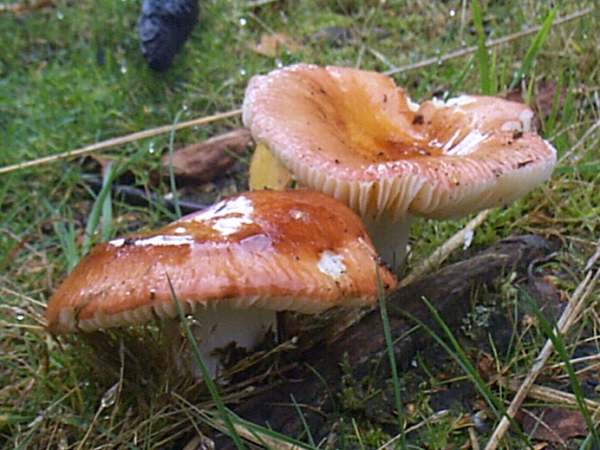
Russula vesca, The Flirt, is also referred to in some current field yuides as the Bare Toothed Brittlegill; this is because of an approximately 1mm wide margin around the rims of mature caps where the pellicle does not quite cover the ends of the gills.
Distribution
The Flirt is common and widespread in Britain and Ireland and wherever there are oak or Beech trees on mainland Europe.
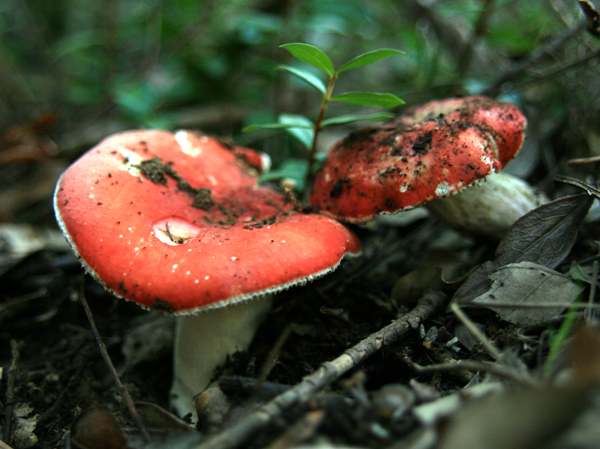
The gills and stem surface of this brittlegill rapidly turn a deep salmon or rusty-pink when rubbed with iron salts (FeSO4) and react rapidly positive (turning blue) with Guaiac tincture; these are useful field tests because the colour of caps of The Flirt and of several other pinkish-red brittlegills are so variable that cap colour is of limited value as a diagnostic feature.
Taxonomic history
Russula vesca was described and named in 1836 by the famous Swedish mycologist Elias Magnus Fries.
Synonyms of Russula vesca include Russula mitis Rea.
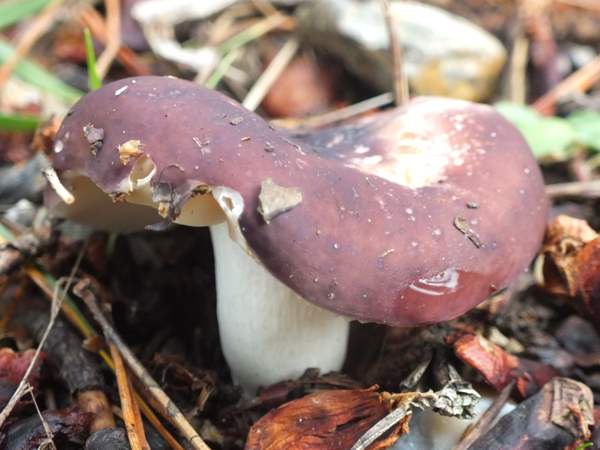
Etymology
Russula, the generic name, means red or reddish, and indeed many of the brittlegills have red caps (but many more are not, and several of those that are usually red can also occur in a range of other colours!).
The specific epithet vesca means edible - as of course do several other Latin words that appear in mushroom species names, such as esculenta, although tere's a trap. Not all species with 'esculenta' in their names are safe to eat, although when they were named they were thought to be!
Identification guide
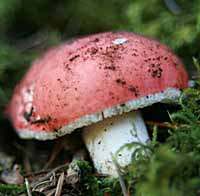 |
CapCaps of Russula vesca are very variable in colour, ranging from deep wine-red to buff, sometimes with brown, olive or green tints; however, Geoffrey Kibby in his superb book The Genus Russula in Great Britain, says that the colour of 'old ham' is a very accurate description. The cap has a smooth surface and is 5 to10cm across, initially globose, becoming convex and sometimes developing a shallow central depression. The cuticle of mature specimens does not quite reach the margin - typical shortfall about 1mm - and so the cap flesh and gill edges are visible from the top. The cuticle peels about 50% from the cap margin. |
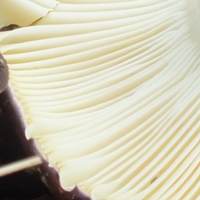 |
GillsAdnexed; white or very pale cream; spacing fairly close; narrow; forked near to the stem. Stem3 to 10cm long and 1.5 to 2.5cm in diameter; white surface and white flesh. |
SporesOvoid (egg-shaped), 6.4-8 x 5.3-5.8µm, ornamented with warts up to 0.5µm tall and mostly isolated from one another but sometimes with just a few connectives. Spore printWhite. |
|
Odour/taste |
A mild nutty taste; no distinctive odour. |
Habitat & Ecological role |
Russula vesca is particularly common in Beech woodland in Britain and Ireland but, particularly on mainland Europe, it is also found in spruce plantations on neutral or acidic soil. In common with other members of the Russulaceae, Russula vesca is an ectomycorrhizal mushroom. |
Season |
July to October in Britain and Ireland. |
Similar species |
Russula xerampelina, the Crab Brittlegill, smells strongly of fish or shellfish. |
Culinary Notes
As its specific epithet declares, Russula vesca is an edible brittlegill - in fact many people consider this to be one of the very finest of wild mushrooms. Unfortunately The Flirt rarely fruits in throngs, but more commonly as isolated singletons or very small widely scattered groups. This mild-tasting mushroom retains a nice firm texture after being cooked. Sautéed with onions and garlic, these chunky mushrooms can be served with meat dishes; alternatively they make nice omelette fillings or they can be used in mushroom soups or stews.
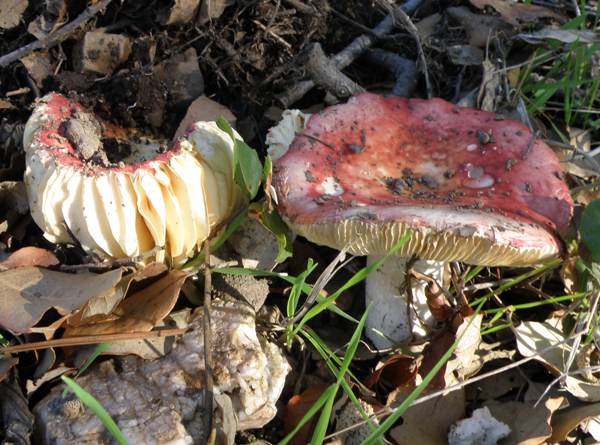
Reference Sources
Pat O'Reilly (2016). Fascinated by Fungi, First Nature Publishing
Geoffrey Kibby (2011).The Genus Russula in Great Britain, published by G Kibby.
Roberto Galli (1996). Le Russule. Edinatura, Milan.
Paul M. Kirk, Paul F. Cannon, David W. Minter and J. A. Stalpers. (2008). Dictionary of the Fungi; CABI.
Taxonomic history and synonym information on these pages is drawn from many sources but in particular from the British Mycological Society's GB Checklist of Fungi.
Fascinated by Fungi. Back by popular demand, Pat O'Reilly's best-selling 450-page hardback book is available now. The latest second edition was republished with a sparkling new cover design in September 2022 by Coch-y-Bonddu Books. Full details and copies are available from the publisher's online bookshop...

